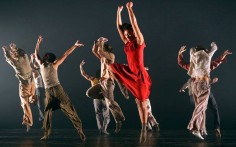HOFESH SHECHTER
Political Mother

source: melodydotconblogspot
謝克特擅長營造強烈的超現實舞台圖像,舞台燈光的運用,打造出具有戲劇張力的畫面。
從小培養的音樂素養,讓他十分講究音樂的運用,除了畫面撼人,更添幾分聽覺煽動力。
泰晤士報稱其:
「這是一齣狂暴的作品,面對萬能邪惡的力量,發自內心深處的怒吼與反抗,振奮人心!」
英國衛報讚譽:
「謝克特在《政治媽媽》運用他最具個人特色的主題,拆解國家和社會機制的難題,
… … 謝克特給了我們勇氣,讓我們得以重新思考這個世界的歷史。」
非常震撼,我坐在第六排,很清楚看見舞者們的臉部表情和動作細節強烈的鼓聲作為開場,隊形變化 跑位 漸層真的非常精彩。
讓我印象最深刻的是燈光變化,配合得太好了。
有一段他們以燈光呈現出電影的分鏡畫面,我知道我這樣說很抽象……但我從來沒想過原來舞碼可以這樣排,真的太驚人。
舞者們用身體反覆的抖動,高舉雙手,急促踏步表現出在此政治體系下的生活就像早期黑奴們用舞蹈來抒發情緒,黑人工作歌進而演化成現今所為的藍調(Blues)。
.
.
.
.
.
.
.
source: hofeshcouk
Political Mother brims with Shechter’s emotional and gritty complexity. Pulsating live music, extraordinary ensemble sequences, and cinematic editing make Political Mother a dance experience like no other.
Performed by 10 dancers, and accompanied by Shechter’s cinematic score featuring a band of live drummers and electric guitarists.
Political Mother promises to draw audiences back to Shechter’s world whose astonishing unisons, percussive grooves and raw, honest physicality mark him as one of the most exciting artists to emerge in recent years.
.
.
.
.
.
.
.
source: nytimes
“Political Mother,” the first evening-length work by the Israeli-born choreographer Hofesh Shechter, arrived at the Brooklyn Academy of Music on Thursday laden with praise and a warning. In Britain, where Mr. Shechter’s company is based and where he has become a dance world star, this 2010 dance received widespread acclaim for its theatricality and political commentary. The warning had to do with the volume of Mr. Shechter ’s score of drums and heavy-metal guitar: loud.
The music is indeed loud, though no louder than at your average rock concert. The warning should have been about the work’s structure, which is designed to frustrate.
As a theater artist, Mr. Shechter borrows much from cinema. “Political Mother” has an opening title sequence, in which a samurai stabs himself in seppuku, or ritual suicide. At the end the whole show speedily reverses, as if someone had hit a rewind button. In between there’s a profusion of jump cuts, blackouts so frequent that you might imagine the lighting as a small-lunged singer who has to keep taking breaths.
Though it seems compulsive, this jittery editing is an example of Mr. Shechter’s tight control over what we see.
At the back of the stage, behind a transparent wall, stands a martial row of drummers. On a level above them is a line of thrashing guitarists with a screaming vocalist in the middle. Throughout the show the musicians appear and disappear, the screaming vocalist sometimes becoming a screaming orator, a dictator perhaps, underlining the aesthetic similarities between rock concerts and fascist rallies.
The 12 dancers move like shellshocked soldiers or a cowed populace. Their posture is slumped, their eyes blank. The vocabulary is folk dance, a kind of lobotomized “Fiddler on the Roof,” but liquefied. Over and over, the shuffling dancers snap into lines and circles, then scatter, chopping up the action even further with their comings and goings.
Mr. Shechter, in interviews, has suggested that this signifies that we are all really just emotionally needy beasts, easily controlled. It’s an idea he has often explored and one probably best not put into words. Loops in the music and loops in the dance suggest loops in the artist’s vision.
Mr. Shechter may be after something more ambiguous: the appeal and the danger of belonging. That ambiguity is most apparent in a motif of hands raised overhead. Directed toward the musicians, it reads as worship. Elsewhere it’s a plea for mercy (as in a stickup; there is a gun). When raised hands join with the raised hands of others, it’s a sign of solidarity or an invitation for applause.
But any ambiguity is undercut by Mr. Shechter’s penchant for high contrast: the darkness and the bright lights, a facile alternation between hard rock and the soft sounds of Verdi and Bach (interrupted, of course). The dance has many false endings, and each is a letdown.

